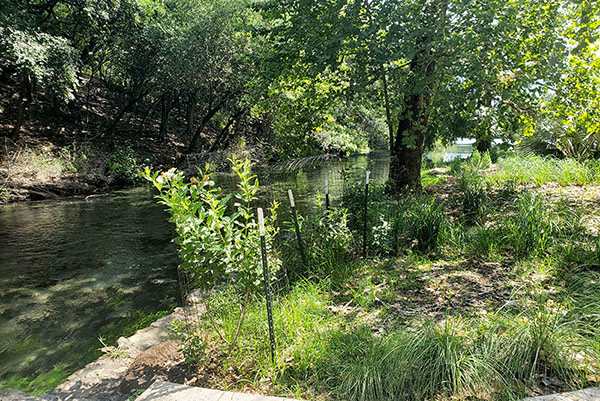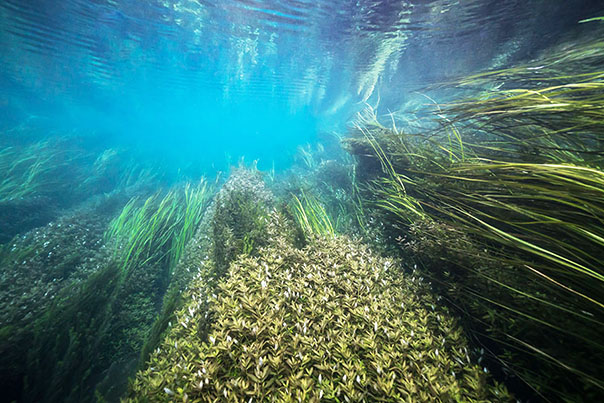Habitat Protection Measures

Comal Springs
Comal Springs ecosystem is the largest spring system in Texas as well as the southwestern United States. Its springs come from the Edwards Aquifer and are located mainly in Landa Park in New Braunfels, Texas. The system is comprised of four major spring runs that feed into Landa Lake and a large number of smaller springs present in Landa Lake. The springs create the largest mean discharge of any spring in the southwestern United States and ultimately the headwaters of the Comal River, the shortest river in Texas. The system exhibits near constant temperatures of about 74º F. Over the years extensive development along the lake and river banks, channel modification, and the natural variability of the springs has resulted in some biological impact.
Brune, G., 1981. Springs of Texas. Vol. 1 Branch-Smith inc., Forth Worth, Texas.
Comal Springs’ Habitat Protection Conservation Measures
- Flow-Split Management in the Old and New Channel (EAHCP § 5.2.1)
- Native Aquatic Vegetation Restoration and Maintenance (EAHCP § 5.2.2)
- Old Channel Restoration (EAHCP §§ 5.2.2.1/ 5.2.2.3)
- Comal River Restoration (EAHCP §§ 5.2.2.2/5.2.2.3)
- Management of Public Recreation Use of Comal Springs and River Ecosystems (EAHCP § 5.2.3)
- Decaying Vegetation Removal and Dissolved Oxygen Management (EAHCP § 5.2.4)
- Control of Harmful Non-Native Animal Species (EAHCP §§ 5.2.5/5.2.9)
- Monitoring and Reduction of Gill Parasites (EAHCP §§ 5.2.6/6.3.6)
- Prohibition of Hazardous Materials Transport Across the Comal River and Its Tributaries (EAHCP § 5.2.7)
- Native Riparian Habitat Restoration – Comal Springs riffle beetle (EAHCP § 5.2.8)
- Reduction of Non-Native Species Introduction and Live Bait Prohibition (EAHCP § 5.2.9)
- Litter Collection and Floating Vegetation Management (EAHCP § 5.2.10)
- Management of Golf Course Diversions and Operations (EAHCP § 5.2.11)
- Native Riparian Habitat Restoration (EAHCP § 5.7.1)
- Management of Household Hazardous Wastes (EAHCP § 5.7.5)
- Impervious Cover/Water Quality Protection (EAHCP § 5.7.6)

San Marcos
The San Marcos Springs ecosystem is the second largest in Texas and has the most environmental stability and flow reliability of any spring system in the southwestern United States. This spring system has never stopped flowing in recorded history. The stability of its springflow helps support the rare flora and fauna found in Spring Lake and in the San Marcos River. Temperatures remain nearly constant year-round at about 70°F. The biological uniqueness and high degree of endemism found in Spring Lake and in the upper San Marcos River can be attributed to its stable temperatures and clear water. Along the San Marcos River, construction and residential development continues to occur, although historically to a lesser degree than along the Comal River.
Brune, G., 1981. Springs of Texas. Vol. 1 Branch-Smith inc., Forth Worth, Texas.
San Marcos’ Habitat Protection Conservation Measures
- Texas wild-rice Enhancement and Restoration (EAHCP §§ 5.3.1/5.4.1)
- Management of Recreation in Key Areas (EAHCP §§ 5.3.2/5.4.2)
- Management of Aquatic Vegetation and Litter Below Sewell Park (EAHCP § 5.3.3)
- Prohibition of Hazardous Materials Transport Across the San Marcos River and Its Tributaries (EAHCP § 5.3.4)
- Reduction of Non-Native Species Introduction (EAHCP §§ 5.3.5/5.4.11)
- Designation of Permanent Access Points/Bank Stabilization (EAHCP § 5.3.7)
- Control of Non-Native Plant Species (EAHCP §§ 5.3.8/5.4.3/5.4.12)
- Control of Harmful Non-Native and Predator Species (EAHCP §§ 5.3.9/5.4.13)
- Management of Floating Vegetation Mats and Litter (EAHCP §§ 5.3.3/5.4.3)
- Management of Golf Course and Grounds (EAHCP § 5.4.9)
- Native Riparian Restoration (EAHCP § 5.7.1)
- Impervious Cover/Water Quality Protection (EAHCP § 5.7.6)
- Management of Household Hazardous Wastes (EAHCP § 5.7.5)
- Prohibition of Hazardous Material Transport (EAHCP § 5.3.4)
Find Out About the EAHCP
The Edwards Aquifer Habitat Conservation Plan
The Partners
Contact Information
EAHCP
EAHCP Steward Newsletter
Stay in touch with all of the happenings of the Edwards Aquifer Habitat Conservation Plan.
 Conditions
Conditions

 CURRENT
CURRENT 
